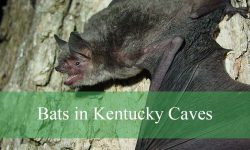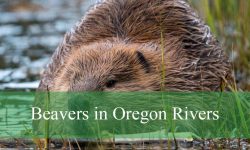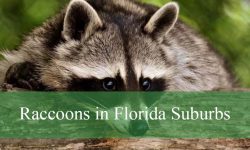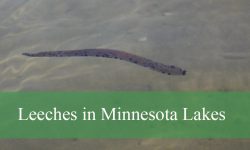Louisiana hosts a rich variety of bird species, making it a favorite destination for birdwatchers and outdoor enthusiasts. The state’s diverse environments—from forests and swamps to cities and farmlands—provide homes for many different birds. This diversity means there is always something new to see for anyone interested in birds.
In this article, you will discover 35 common birds in Louisiana. Each species is described with clear details and identification tips to help you recognize them easily. Alongside pictures, you’ll learn about their colors, sizes, behaviors, and typical habitats.
Bird populations in Louisiana vary throughout the year, with some species staying all year and others passing through during migration. Understanding the habits and habitats of these birds will enhance your birdwatching adventures in this vibrant state. Let’s dive into the fascinating world of birds in Louisiana.
Different Types of Birds in Louisiana
Red-winged Blackbird (Agelaius phoeniceus)
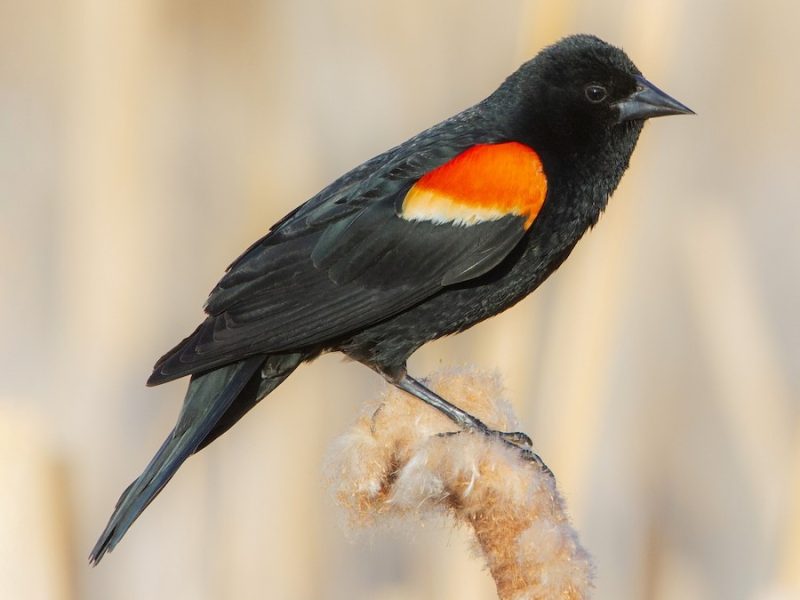
The Red-winged Blackbird is easily recognized by the bright red and yellow shoulder patches on the male’s otherwise black body. Females look quite different, with streaked brown plumage that helps them blend into marsh vegetation. Males perch prominently and sing a distinctive “conk-a-ree” song to mark their territory during breeding season.
Measuring about 7 to 9 inches in length, these birds are medium-sized and show strong sexual dimorphism in both appearance and behavior. Males are territorial and can be aggressive, especially in spring, often chasing away intruders near their nesting sites.
In Louisiana, Red-winged Blackbirds are commonly found near wetlands, marshes, rice fields, and grassy edges of ponds and lakes. They feed on seeds, grains, and insects, often forming large flocks outside the breeding season. These birds are year-round residents in the state but become more vocal and visible during warmer months.
Mourning Dove (Zenaida macroura)
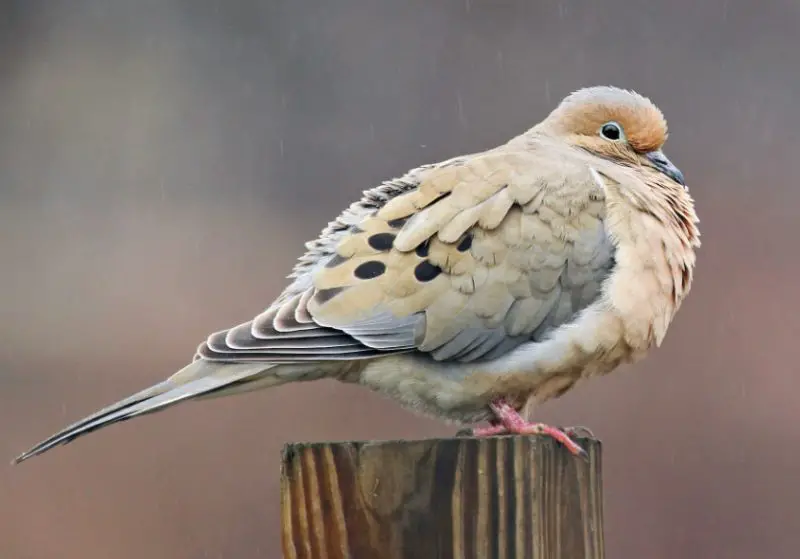
The Mourning Dove is a slender, graceful bird easily identified by its soft gray-brown color and long, pointed tail. Its name comes from the mournful, cooing sound it makes, which is often heard in the early morning or evening. The black spots on its wings and the subtle blue ring around its eyes help distinguish it from other doves.
Adults measure about 9 to 13 inches long, with a wingspan ranging from 17 to 18 inches. Despite their delicate appearance, they are strong fliers and can reach speeds of over 50 miles per hour. Their behavior is generally peaceful, and they are often seen foraging in pairs or small groups on the ground.
Mourning Doves are abundant throughout Louisiana in cities, farmland, grasslands, and even forest edges. They feed mainly on seeds, which they pick from the ground or from low vegetation. These birds are year-round residents in the state and are also commonly seen perching on telephone wires or rooftops.
Blue Jay (Cyanocitta cristata)
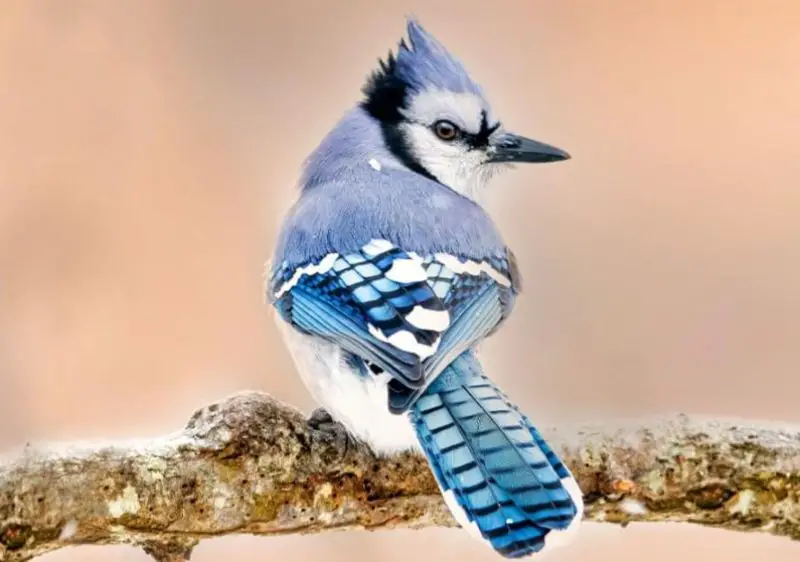
The Blue Jay is a bold and noisy bird known for its vibrant blue coloration and loud calls. Its feathers show a beautiful mix of blue, white, and black, with a crest on the head that can be raised or lowered depending on its mood. Its intelligence and mimicking abilities, especially of hawk calls, make it a fascinating bird to observe.
Typically around 9 to 12 inches in length with a wingspan of about 13 to 17 inches, the Blue Jay is slightly larger than most songbirds. It is curious and often engages in acrobatic behavior, especially when feeding. They are known to cache food, storing acorns and nuts for later consumption.
In Louisiana, Blue Jays inhabit mixed forests, urban neighborhoods, and parks. They thrive in areas with oak trees due to their fondness for acorns. Their diet is varied and includes insects, seeds, nuts, and occasionally eggs or nestlings of other birds. They are present year-round and are easily spotted by their flashy color and vocalizations.
Northern Cardinal (Cardinalis cardinalis)
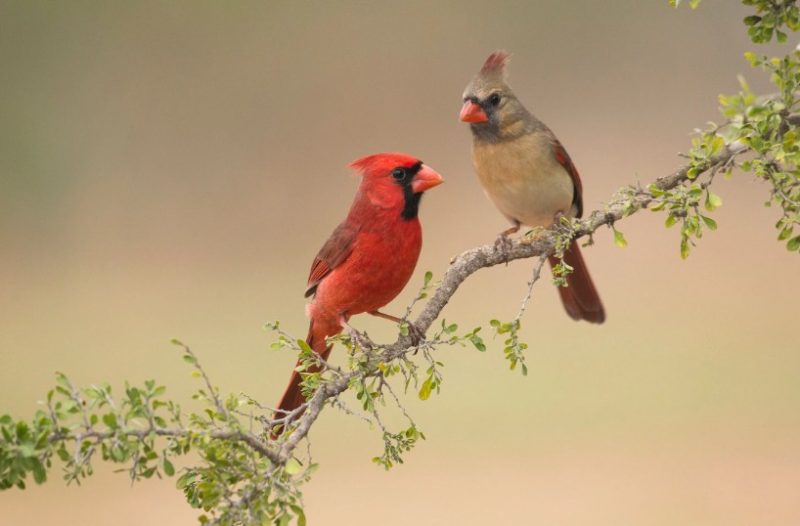
The Northern Cardinal is one of the most recognizable birds in Louisiana and holds the honor of being the state bird. Males are bright red with a black mask around their beaks, while females are more subdued with tan or light brown plumage and hints of red on the wings and tail. Both sexes have a distinctive crest on top of their heads and a thick orange-red beak. Their songs are clear and whistling, often heard during early mornings.
These birds are medium-sized, typically about 8 to 9 inches in length with a wingspan around 10 to 12 inches. They do not migrate and can be seen throughout the year, even during winter when their red feathers contrast beautifully with the bare landscape. Northern Cardinals are frequent visitors to backyard feeders, especially those offering sunflower seeds.
Northern Cardinals are commonly found in woodlands, thickets, suburban gardens, and city parks across Louisiana. They prefer areas with dense shrubbery for nesting and protection. Their diet includes seeds, berries, and insects, making them well-adapted to both rural and urban environments.
Carolina Wren (Thryothorus ludovicianus)
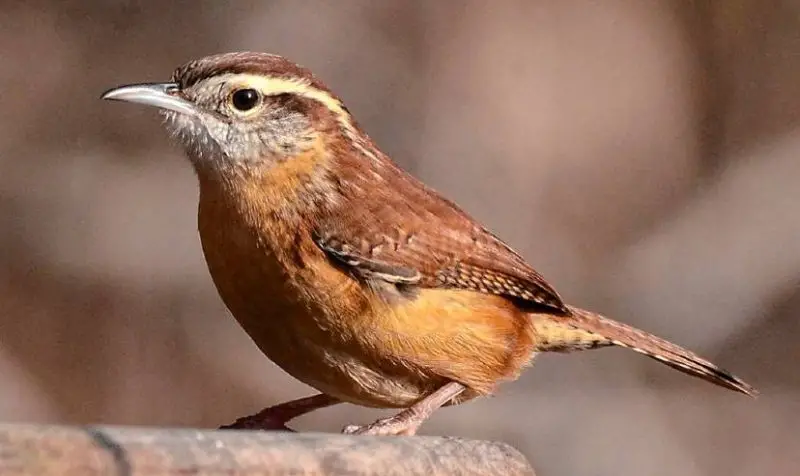
The Carolina Wren is a small yet energetic bird known for its loud and cheerful song that can be heard throughout the year. It has warm brown upperparts, a buff-colored belly, and a prominent white eyebrow stripe that makes it easy to identify. Its slightly curved bill and upright tail posture give it a distinct silhouette.
This bird is about 4.7 to 5.5 inches long with a wingspan of around 11 inches. It is often seen darting around brushy areas, woodpiles, and porches, where it searches for insects and spiders. Despite its small size, the Carolina Wren is bold and curious, frequently exploring nooks and crannies around human dwellings.
In Louisiana, the Carolina Wren thrives in suburban backyards, gardens, forests, and overgrown lots. It nests in a wide variety of sheltered spots, including hanging baskets and mailboxes. Its diet consists mainly of insects, but it will also eat seeds and berries, especially in winter. This bird is a year-round resident and a familiar companion to many Louisiana homeowners.
Northern Mockingbird (Mimus polyglottos)
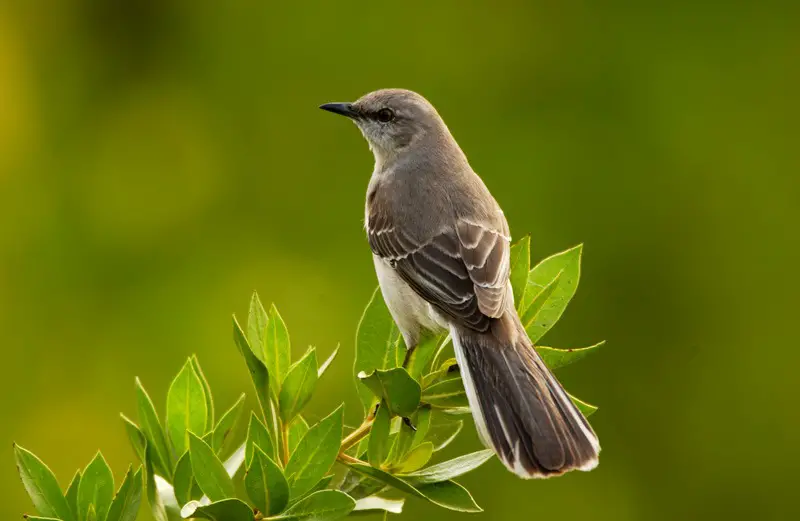
The Northern Mockingbird is the national bird of the United States and a familiar sight throughout Louisiana. It is medium-sized, with gray plumage, a paler underside, and distinctive white patches on its wings and tail that are especially visible during flight. This bird is most known for its remarkable ability to mimic the songs of other birds and even mechanical sounds.
Mockingbirds are typically about 9 to 10 inches long with a wingspan around 12 to 14 inches. They are often seen perched on fences, power lines, rooftops, and open branches, keeping a close watch over their territory. Highly territorial, they will vigorously defend their nesting area from intruders, sometimes even chasing off larger birds or animals.
Northern Mockingbirds are commonly found in suburban neighborhoods, parks, gardens, and farmland across Louisiana. They thrive in open areas with sparse trees or shrubs and feed on a variety of insects, berries, and fruits. These adaptable birds are year-round residents and often provide an early morning concert with their rich and varied songs.
American Robin (Turdus migratorius)
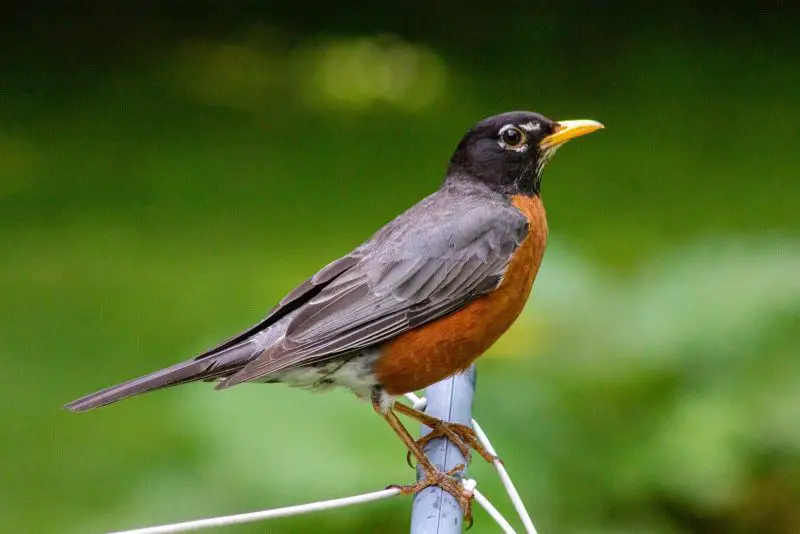
The American Robin is one of the most recognizable and widespread songbirds in North America and is particularly common in Louisiana during spring and fall. With its reddish-orange breast, grayish back, and yellow bill, the robin is easy to identify. Males and females look similar, although males often appear more vividly colored.
Measuring about 9 to 11 inches in length with a wingspan of 12 to 16 inches, American Robins are frequently seen hopping across lawns in search of earthworms, especially after rain. They also feed on insects and fruits, depending on the season. Their sweet, melodic song is a sure sign of spring in many regions.
In Louisiana, robins can be found in woodlands, parks, gardens, and residential areas. While some robins are year-round residents in the state, large flocks often migrate through in spring and autumn. They are highly social in winter and may form large roosts in trees, especially near fruiting plants.
Common Grackle (Quiscalus quiscula)

The Common Grackle is a large blackbird with glossy, iridescent feathers that shimmer with hints of purple, green, and blue in the sunlight. It has a long tail, a slightly downcurved bill, and pale yellow eyes that give it a striking look. Its vocalizations are harsh and metallic, quite different from the melodies of other songbirds.
These birds measure between 11 to 13 inches long with a wingspan of up to 18 inches, making them one of the larger songbirds in the region. Grackles are social and often gather in large flocks, especially outside the breeding season. They walk rather than hop and can often be seen strutting across parking lots, fields, and lawns.
In Louisiana, Common Grackles are widespread and often seen in agricultural areas, city parks, and suburban neighborhoods. They feed on insects, seeds, grains, and even small animals like frogs or eggs. These birds are opportunistic and are known to forage in garbage or agricultural waste, making them highly adaptable to urban environments.
European Starling (Sturnus vulgaris)
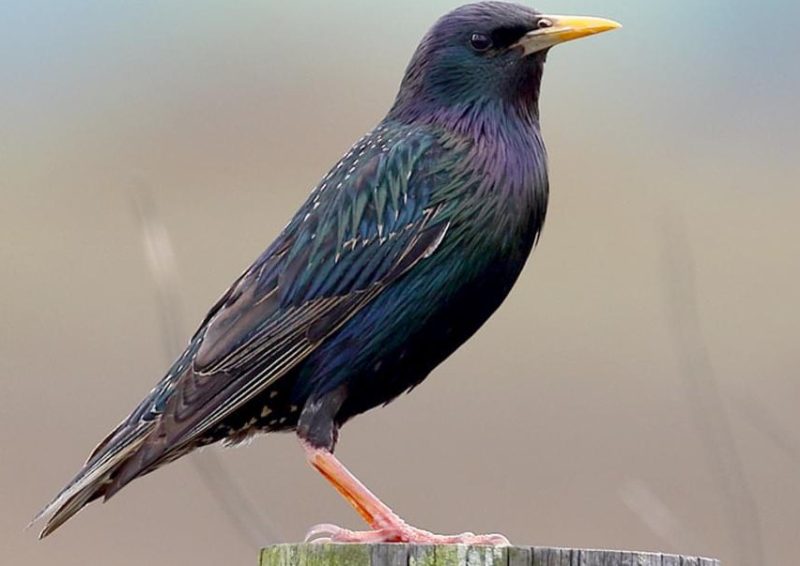
The European Starling is a non-native bird species that has become firmly established in Louisiana and across North America. Adults have glossy black plumage speckled with white spots, especially in winter, and show a purplish-green iridescence in summer. They have short tails, pointed wings, and sharp, yellow bills during breeding season.
Measuring about 7.5 to 9 inches long with a wingspan of 12 to 16 inches, starlings are very agile fliers and can form enormous flocks known as murmurations. These synchronized group flights are a spectacular sight in the sky. Their vocal range is wide, and they are known for mimicking other birds and sounds.
Starlings are common in cities, towns, farms, and open countryside throughout Louisiana. They often nest in cavities, including vents, eaves, and birdhouses. Their diet includes insects, fruits, seeds, and scraps from human food. Despite their beauty, they are considered invasive and can outcompete native bird species for nesting sites.
House Sparrow (Passer domesticus)
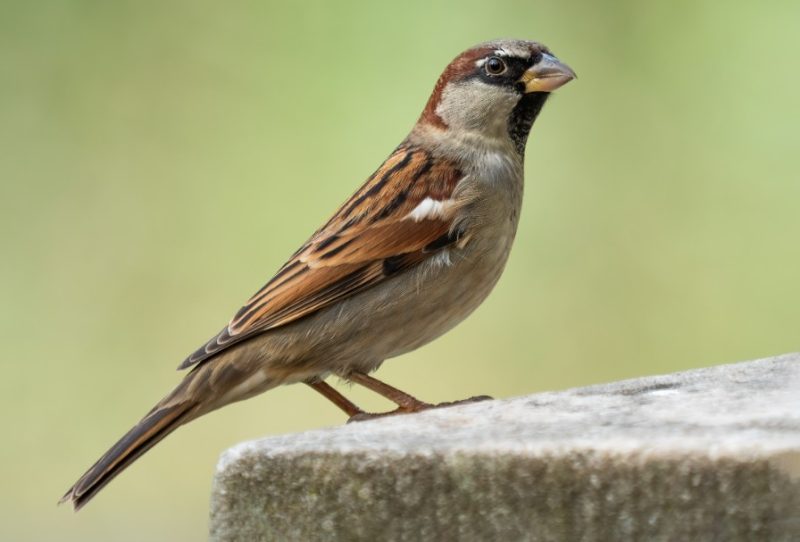
The House Sparrow is a small, stocky bird that lives closely alongside humans and is frequently seen in Louisiana’s residential and urban areas. Males have a gray crown, chestnut nape, black bib, and light brown body streaked with darker tones, while females and young birds are more uniformly brown and less distinctive.
These birds are about 6 inches long with a wingspan of 7.5 to 9.8 inches. They are social, often feeding in groups and chirping noisily from rooftops, hedges, or streetlights. House Sparrows are aggressive competitors for nesting sites and are known to displace native birds from birdhouses or building crevices.
In Louisiana, House Sparrows are year-round residents found near homes, schools, barns, and shopping centers. Their diet includes grains, seeds, and scraps from human activity, making them common around fast food areas and outdoor restaurants. Though introduced from Europe, they have become a permanent and familiar part of Louisiana’s avian landscape.
Red-bellied Woodpecker (Melanerpes carolinus)

The Red-bellied Woodpecker is a common sight in Louisiana backyards, especially where mature trees are present. Despite its name, the red on its belly is often faint and hard to spot. More noticeable is the bright red cap extending from the bill to the nape in males, while females have red only on the nape. Its black-and-white barred back makes it easy to identify as it climbs tree trunks.
This medium-sized woodpecker measures about 9 to 10.5 inches in length with a wingspan of 13 to 17 inches. It frequently drums on tree bark or even utility poles, creating loud, rhythmic tapping sounds. Red-bellied Woodpeckers are known for their loud, rolling “churr” calls and agile movements as they forage along trunks and branches.
In Louisiana, they inhabit woodlands, parks, and suburban neighborhoods with plenty of tall trees. Their diet is varied and includes insects, nuts, seeds, and fruits. They often visit bird feeders, particularly those offering suet or sunflower seeds. These woodpeckers are year-round residents and contribute to the lively sounds of southern forests.
Downy Woodpecker (Dryobates pubescens)
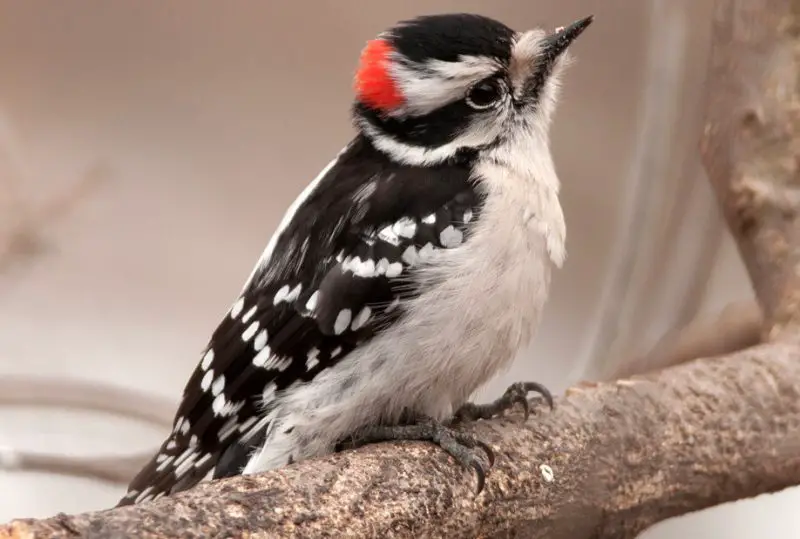
The Downy Woodpecker is the smallest woodpecker species in North America and is frequently found throughout Louisiana. It has a white underside, black wings with white spots, and a short, stubby bill. Males feature a small red patch on the back of the head, which is absent in females. Despite its small size, its pecking is distinct and persistent.
Measuring about 5.5 to 6.7 inches long with a wingspan of 9 to 12 inches, the Downy Woodpecker is agile and often seen tapping along smaller branches rather than large trunks. Its call is a sharp “pik” and it also gives a rapid whinnying sound during interactions or courtship.
Downy Woodpeckers thrive in deciduous forests, gardens, and suburban areas across Louisiana. They feed on insects hidden beneath bark, as well as seeds and berries. They readily visit backyard feeders, especially those with suet, and are commonly seen alongside chickadees and titmice in mixed foraging flocks.
Carolina Chickadee (Poecile carolinensis)
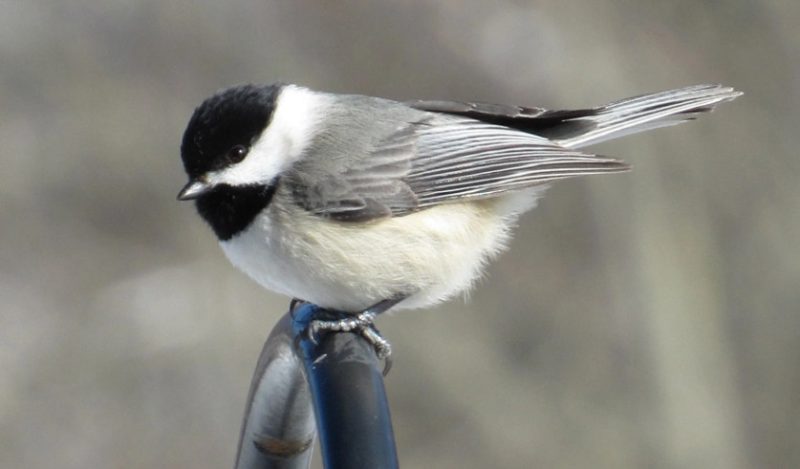
The Carolina Chickadee is a tiny, energetic bird that is a familiar resident throughout Louisiana. It has a distinctive black cap and bib, white cheeks, and soft gray upperparts with lighter underparts. This chickadee’s cheerful “fee-bee-fee-bay” song and constant chatter make it a lively presence in wooded areas and backyards.
Carolina Chickadees are about 4.5 to 5 inches long with a wingspan of 6 to 8 inches. They are very social and are usually found in small groups, especially during the non-breeding season. These birds are curious and often the first to explore bird feeders or new objects in their environment.
In Louisiana, they inhabit mixed woodlands, urban parks, and residential areas with mature trees. Their diet includes insects, spiders, seeds, and berries. They readily use birdhouses and cavity nests and are year-round residents, providing constant movement and song to southern woodlands and gardens.
Tufted Titmouse (Baeolophus bicolor)
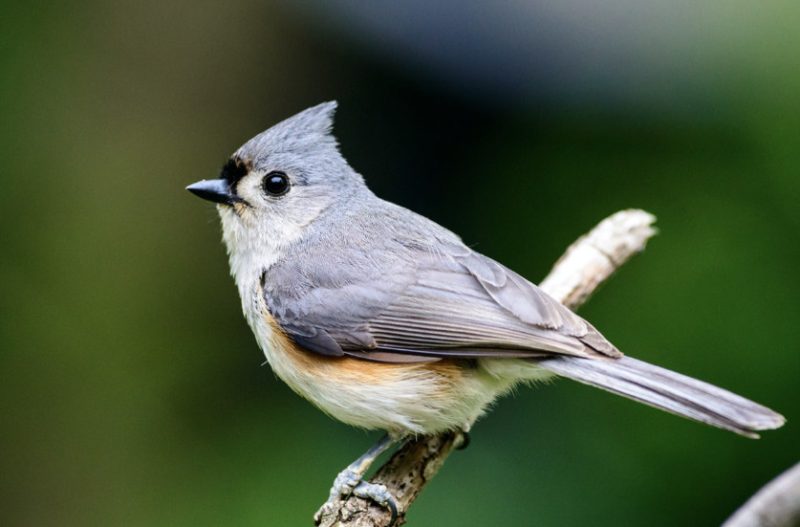
The Tufted Titmouse is a small, charming bird closely related to the chickadee, easily recognized by the gray crest or tuft on its head. It has soft gray upperparts, a white face and belly, and a hint of rust color under the wings. Its large, dark eyes give it an alert and expressive appearance.
These birds are about 5.5 to 6.3 inches in length with a wingspan of 7.9 to 10.2 inches. They are active and often travel in small family groups, frequently joining mixed flocks with chickadees and woodpeckers. Their call is a clear, whistled “peter-peter-peter,” heard often in wooded neighborhoods and forests.
Tufted Titmice are year-round residents in Louisiana and are found in deciduous and mixed forests, as well as well-treed residential areas. Their diet includes insects, seeds, nuts, and berries, and they frequently visit feeders, especially for sunflower seeds and peanuts. They often use tree cavities or nest boxes for breeding.
American Goldfinch (Spinus tristis)

The American Goldfinch is a striking bird, especially in the spring and summer when males sport bright yellow bodies with black caps and black wings. Females are more subdued in color, with olive-yellow tones and darker wings. In winter, both sexes adopt a more muted brownish-gray appearance but retain their distinctive wing markings.
These small songbirds measure about 4.3 to 5.1 inches long with a wingspan of 7.5 to 8.7 inches. They have a bouncy, undulating flight pattern and emit cheerful calls that sound like “per-chick-o-ree.” They are social and often travel in flocks, especially during migration or while feeding.
In Louisiana, American Goldfinches are commonly found in open fields, weedy patches, and backyards with seed-bearing plants. Their diet mainly consists of seeds, particularly from sunflowers, thistles, and coneflowers. They also visit feeders stocked with nyjer or black-oil sunflower seeds. Though more numerous in winter, some may remain in the state year-round.
Eastern Bluebird (Sialia sialis)
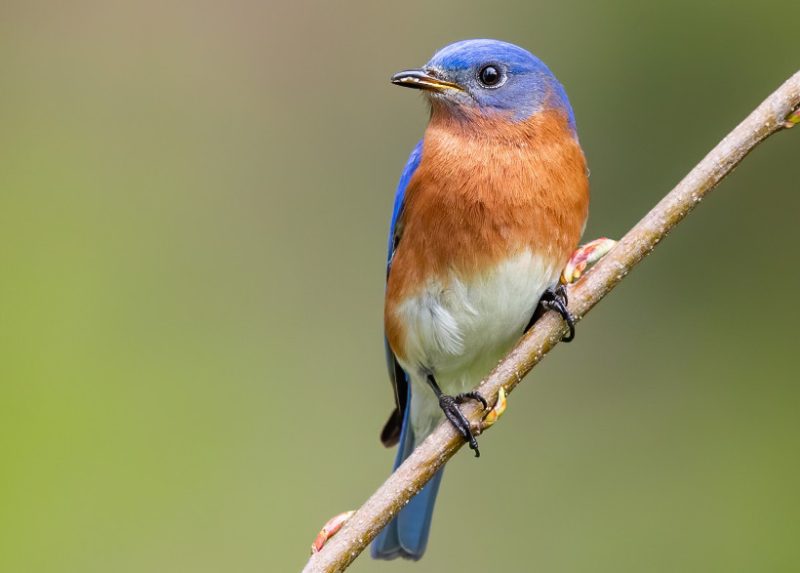
The Eastern Bluebird is a charming and colorful bird often seen in rural parts of Louisiana, especially in pastures, open fields, and even golf courses. Males have brilliant blue upperparts and a warm reddish-orange breast, while females display a more muted combination of blue-gray and pale orange. Their upright posture and gentle calls make them easy to recognize.
These birds are small to medium-sized, measuring about 6.5 to 7.5 inches long with a wingspan of 9.8 to 12.6 inches. They frequently perch on fences, wires, or low branches, scanning the ground for insects. Their song is a soft, melodious series of notes that adds to the peaceful atmosphere of countryside settings.
In Louisiana, Eastern Bluebirds prefer open habitats with scattered trees and low vegetation. They nest in cavities, often using nest boxes, and their diet consists of insects, caterpillars, and berries. They are year-round residents in the state and are especially welcome in gardens where nest boxes are provided.
Great Egret (Ardea alba)
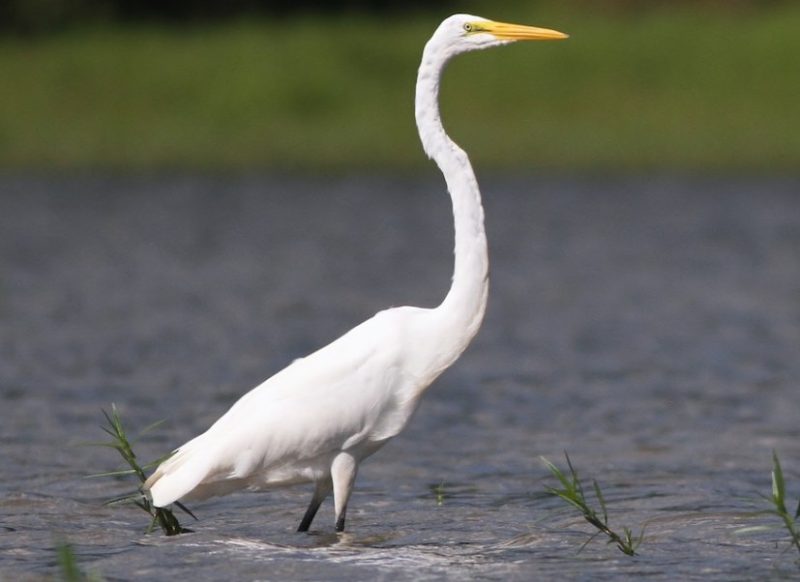
The Great Egret is a large, elegant bird with entirely white plumage, a long S-shaped neck, and a sharp yellow bill. It is commonly seen in Louisiana standing motionless near ponds, marshes, or lake shores. Its long black legs and graceful posture make it a distinctive figure among wetland birds.
Great Egrets measure about 37 to 41 inches in length with an impressive wingspan of 51 to 57 inches. They move slowly and deliberately, using their spear-like bill to catch fish, frogs, and small aquatic animals. During the breeding season, they develop long, wispy plumes on their back, which were once highly sought after for fashion.
In Louisiana, Great Egrets are widespread in coastal marshes, swamps, riverbanks, and flooded fields. They nest in colonies, often with other wading birds, in trees or shrubs over water. These birds are permanent residents in the state and can be observed year-round, especially in wetlands and shallow waterways.
Great Blue Heron (Ardea herodias)
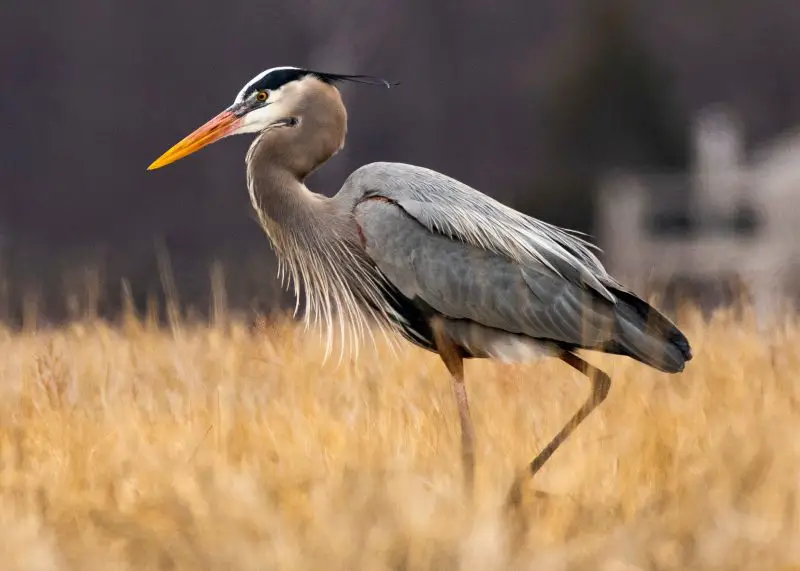
The Great Blue Heron is the largest heron in North America and is frequently seen in Louisiana near lakes, ponds, rivers, and marshes. Despite its name, it appears mostly grayish-blue with a long neck, dagger-like yellow bill, and long legs. Its flight is slow and majestic, with deep wingbeats and its neck folded back in an S-shape.
This bird stands about 38 to 54 inches tall with a wingspan of 65 to 80 inches. It is usually found hunting alone, slowly stalking through shallow water before striking quickly at fish or frogs. Great Blue Herons are solitary feeders but may gather in groups to nest in colonies called rookeries.
In Louisiana, they are found throughout the year in both freshwater and coastal wetlands. Their diet includes fish, amphibians, insects, and even small mammals. Their adaptability to both rural and urban water bodies makes them a familiar sight across the state’s diverse wetland habitats.
Snowy Egret (Egretta thula)

The Snowy Egret is a smaller, graceful white heron known for its contrasting black legs and bright yellow feet, often referred to as “golden slippers.” It also has a slender black bill and elegant white plumage, with lacy plumes appearing on the head and back during the breeding season.
These birds are about 22 to 27 inches long with a wingspan of 38 to 41 inches. Unlike the more reserved Great Egret, Snowy Egrets are active foragers, often seen stirring the water with their feet or dashing about to chase prey. Their behavior is lively, and their movements are more energetic and animated.
In Louisiana, Snowy Egrets are commonly found in marshes, tidal flats, rice fields, and lakeshores. They feed on small fish, insects, and crustaceans and are often seen in mixed flocks with other wading birds. They breed in colonies, usually in trees or shrubs near water, and are present year-round in most parts of the state.
Mallard (Anas platyrhynchos)
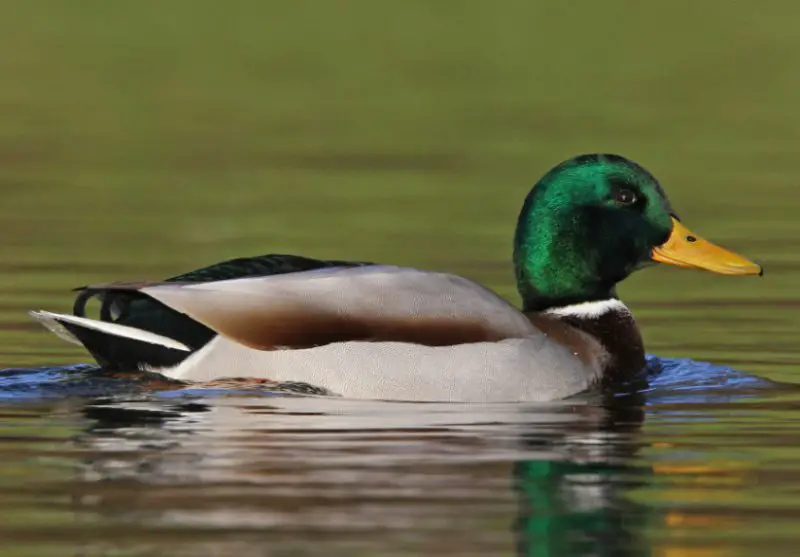
The Mallard is one of the most familiar and widely recognized ducks in Louisiana, often found in ponds, lakes, marshes, and city parks. Males are striking with their glossy green heads, white neck rings, and chestnut-colored breasts, while females are mottled brown with an orange bill and a distinctive blue patch on the wing.
These dabbling ducks are medium to large, measuring about 20 to 26 inches long with a wingspan of 32 to 39 inches. They feed by tipping forward in the water to reach aquatic plants, insects, and small invertebrates, rarely diving. Mallards are often seen paddling in pairs or groups, and their familiar “quack” is one of the most recognizable bird calls.
In Louisiana, Mallards are common throughout the year, especially in urban and suburban parks with water features. They are also abundant in natural wetland areas during migration and winter. As adaptable birds, they often interact comfortably with humans and are a favorite among visitors to public lakes and nature reserves.
Canada Goose (Branta canadensis)
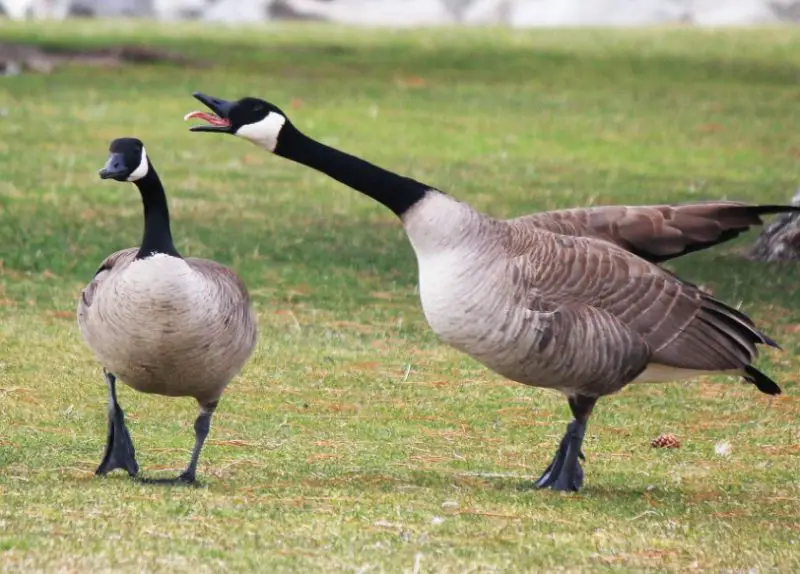
The Canada Goose is a large, familiar bird often seen flying in V-shaped flocks across the Louisiana sky, especially during the colder months. These geese have a distinctive black head and neck, white cheek patches, and a brownish-gray body. Their honking calls are easily recognized during migration.
They measure about 30 to 43 inches long with a wingspan ranging from 50 to 73 inches. While they are graceful in flight, they appear more awkward on land but are strong swimmers and flyers. Canada Geese are social and often gather in large numbers in fields, lakeshores, and open grassy areas.
In Louisiana, Canada Geese are most common during the fall and winter as they migrate southward. They are frequently seen around lakes, ponds, reservoirs, and even golf courses or agricultural fields. Their diet consists of grasses, grains, aquatic plants, and occasionally insects, making them well-suited to a variety of habitats.
Wood Duck (Aix sponsa)
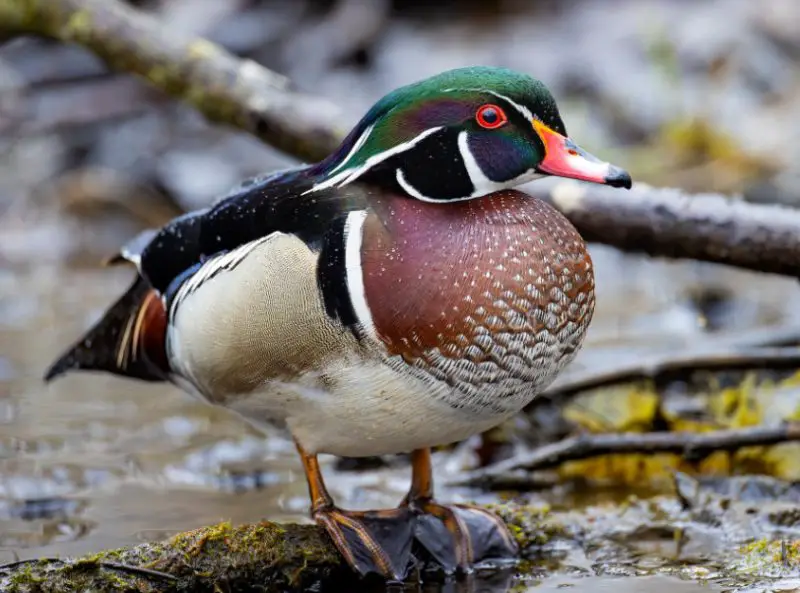
The Wood Duck is one of the most beautiful and colorful birds found in Louisiana’s wetland environments. Males are especially striking, with iridescent green and purple heads, red eyes, and multicolored patterns on the body. Females are more subdued in color but have a distinctive white eye-ring and a soft, rounded appearance.
Wood Ducks are medium-sized, about 18 to 21 inches long with a wingspan of 26 to 29 inches. They have strong claws that help them perch in trees, which is uncommon for ducks. These birds often nest in tree cavities near water and are agile fliers, capable of swift and precise movements through wooded wetlands.
In Louisiana, Wood Ducks are common in forested swamps, bayous, and wooded marshes. They feed on seeds, acorns, aquatic plants, and insects. They are seen year-round in the state and are especially active during early mornings and evenings. Their shy nature and preference for quiet, tree-lined wetlands make them a delightful yet elusive species to observe.
Bald Eagle (Haliaeetus leucocephalus)
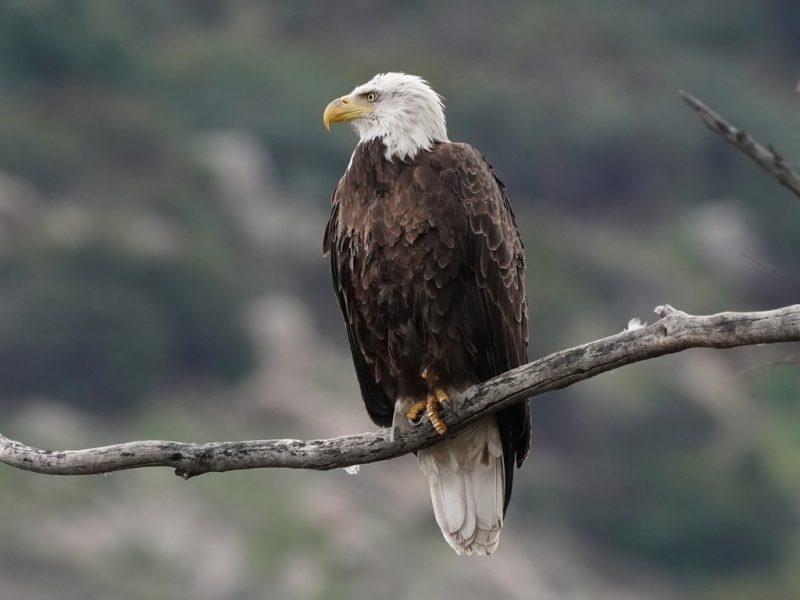
The Bald Eagle, the national symbol of the United States, is a majestic raptor that can be seen in Louisiana, particularly near large lakes and rivers during winter months. Adults are easily identified by their white heads and tails, dark brown bodies, and large yellow beaks. Immature eagles are mostly brown with mottled white markings and take about four to five years to reach adult plumage.
These large birds measure about 28 to 40 inches in length with an impressive wingspan of 70 to 90 inches. Bald Eagles are powerful hunters and scavengers, known for swooping down to snatch fish from the water. They also feed on waterfowl, carrion, and small mammals when fish are scarce.
In Louisiana, they are most often spotted near the Mississippi River, coastal wetlands, and large reservoirs. While some are year-round residents, their numbers increase in winter when northern birds migrate south. Bald Eagles typically nest in tall trees close to water, using massive stick nests that they return to and rebuild each year.
Red-tailed Hawk (Buteo jamaicensis)
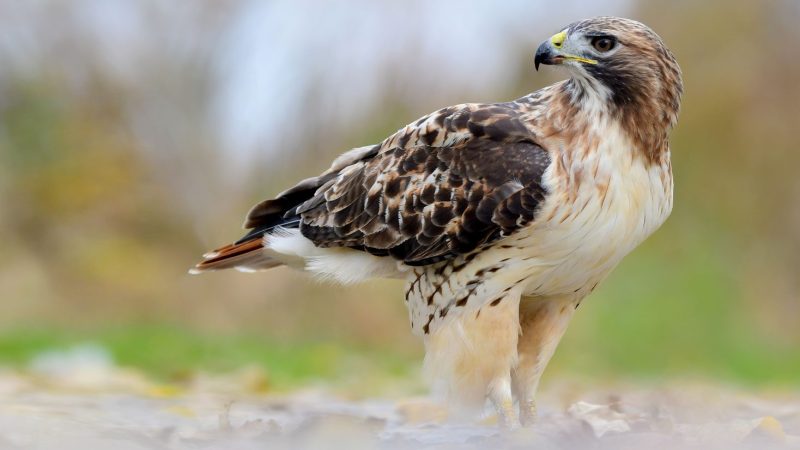
The Red-tailed Hawk is one of the most commonly seen birds of prey in Louisiana. Adults have a rich brown back and pale underparts with a streaked belly, but their most distinctive feature is the broad, reddish tail. Juveniles lack the red tail and appear more heavily marked. Their call is a raspy, descending scream, often used in movies for dramatic effect.
This hawk is large and broad-winged, measuring 18 to 26 inches in length with a wingspan of 43 to 57 inches. It soars with slow, deliberate wingbeats and can be seen gliding high over fields, highways, or perched on utility poles. Red-tailed Hawks are territorial and can often be seen hunting alone.
In Louisiana, they are found year-round in open fields, along highways, and in forest clearings. Their diet includes rodents, rabbits, reptiles, and occasionally birds. Their adaptability to different environments makes them successful hunters and a familiar sight throughout the state.
Turkey Vulture (Cathartes aura)

The Turkey Vulture is a large, dark bird often seen circling high in the sky with its wings held in a shallow V-shape. It has a featherless red head and pale beak, while its wings are dark brown with lighter undersides. This flight posture and its distinctive, wobbly soaring style help distinguish it from other large birds.
Turkey Vultures are about 25 to 32 inches long with a wingspan of 63 to 72 inches. They rarely flap their wings and use thermal air currents to glide for long periods. Unlike many birds, they rely heavily on their strong sense of smell to locate carrion, which is their primary food source.
In Louisiana, Turkey Vultures are common throughout the year and are especially abundant in rural areas, near highways, open fields, and landfills. They roost in large groups in trees or on tall structures and play an essential role in the ecosystem by cleaning up dead animals. Their presence is both eerie and important in maintaining environmental health.
Killdeer (Charadrius vociferus)
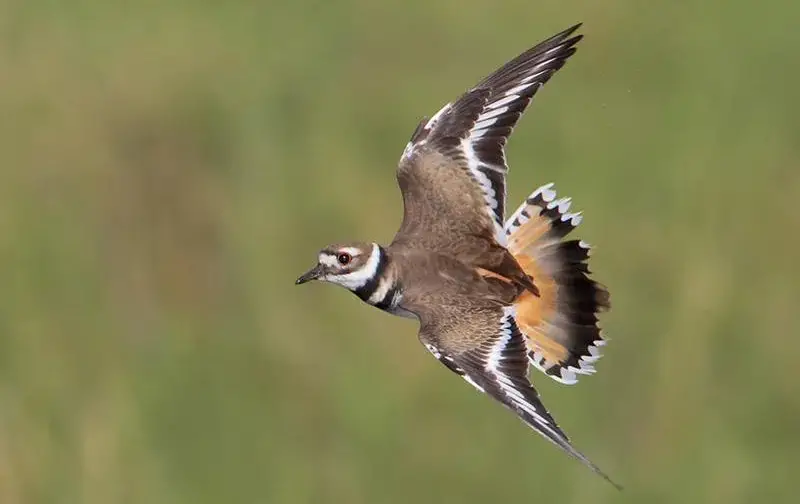
The Killdeer is a small, slender shorebird notable for its distinctive double black breast bands and loud, piercing call. It has a brown back and white belly, with a white stripe above the eye that contrasts with its dark face. Unlike many shorebirds, Killdeer spend much of their time running quickly on open ground rather than wading in water.
Measuring about 8 to 11 inches long with a wingspan of 18 to 20 inches, Killdeer are agile runners that use their speed to escape predators. Their behavior often includes “broken-wing” displays to distract threats away from their nests, which are typically shallow scrapes on bare or gravelly soil.
In Louisiana, Killdeer are common in open fields, gravel lots, mudflats, and construction sites. They prefer bare or sparsely vegetated ground where they can forage for insects, worms, and small invertebrates. Killdeer are present year-round in the state but are especially visible during breeding season in spring and summer.
Barn Swallow (Hirundo rustica)

The Barn Swallow is a sleek, agile bird easily identified by its deep blue upperparts, rusty throat and forehead, and long, deeply forked tail. It is known for its swift, acrobatic flight as it skims low over water or open fields to catch flying insects. Barn Swallows often build cup-shaped mud nests under eaves, bridges, or barn roofs.
These birds measure about 7 to 8 inches in length with a wingspan of 11 to 13 inches. They are social and often seen in flocks, especially during migration. Their cheerful twittering calls and constant activity make them a lively presence in the air.
In Louisiana, Barn Swallows arrive in spring and stay through summer, nesting near water and open farmland. They feed primarily on flying insects, which they catch on the wing. Their nests, made of mud and grass, are commonly attached to human structures, making them a familiar sight around rural homes and barns.
Tree Swallow (Tachycineta bicolor)
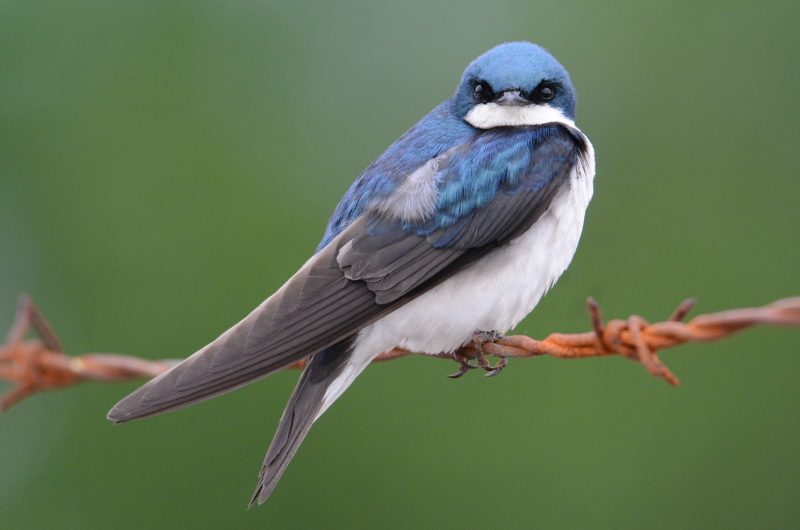
The Tree Swallow is a medium-sized swallow with iridescent blue-green upperparts and bright white underparts. Its slender, streamlined body and short, slightly forked tail aid in swift, graceful flight. Unlike Barn Swallows, Tree Swallows nest in natural or artificial cavities such as tree holes or nest boxes near wetlands.
They are about 5 to 6 inches long with a wingspan of 11 to 13 inches. These birds are migratory and arrive in Louisiana in spring, often forming large flocks before settling down to breed. Their twittering and chirping calls are commonly heard near marshes and ponds.
Tree Swallows inhabit Louisiana’s wetlands, open fields, and lakeshores during breeding season. They primarily feed on flying insects but will also consume berries late in the season. They rely heavily on nesting cavities, making nest boxes an effective way to support their populations.
Purple Martin (Progne subis)
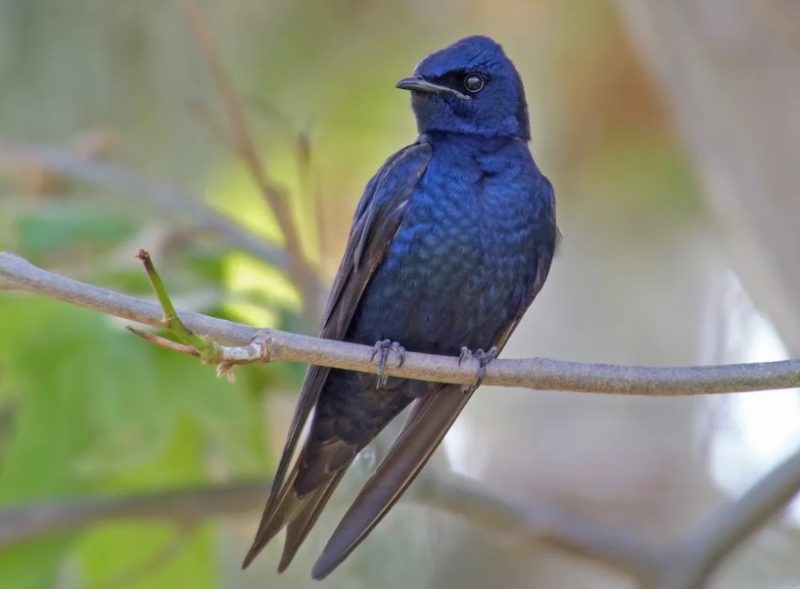
The Purple Martin is the largest North American swallow, known for its glossy, iridescent dark blue-purple feathers and wide, square tails. Males display a uniform dark color, while females and juveniles are paler with some grayish tones on the underparts. Purple Martins are famous for nesting in colonies in birdhouses or “martin houses” provided by humans.
They measure about 7 to 8 inches long with a wingspan of 15 to 17 inches. Their flight is strong and buoyant, characterized by fast wingbeats interspersed with glides. They produce a variety of chattering and warbling calls within their social groups.
In Louisiana, Purple Martins arrive in spring and nest in man-made structures like multi-compartment birdhouses. They prefer open habitats near water and forage for flying insects like dragonflies and beetles. Their dependence on human-provided nesting sites makes them popular among bird enthusiasts who maintain martin houses.
Yellow-rumped Warbler (Setophaga coronata)
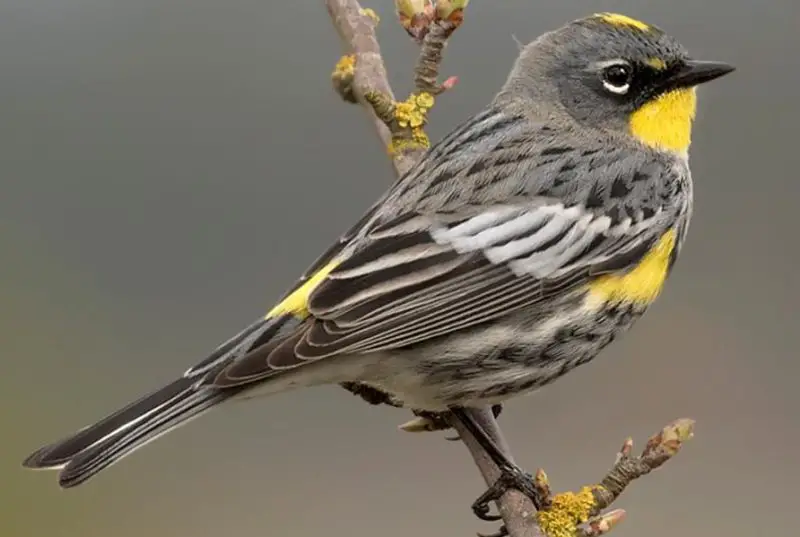
The Yellow-rumped Warbler is a small, energetic songbird easily recognized by the bright yellow patches on its rump, sides, and crown. Its plumage varies seasonally, with breeding males showing bold black, white, and yellow markings, while winter plumage is more muted. These warblers have a sharp, buzzing song and are often quite active.
Measuring about 5 to 6 inches long with a wingspan of 8 to 11 inches, they are agile and quick, frequently flicking their wings and tail as they forage. Yellow-rumped Warblers are known for their adaptability and are among the few warblers able to digest waxy berries like bayberries.
In Louisiana, these warblers migrate through the state during fall and winter, often found in parks, woodlands, and brushy areas. They feed on insects in warmer months and shift to berries and seeds during colder periods. Their colorful presence and distinctive calls make them a common and welcome visitor in Louisiana’s cooler seasons.
White-winged Dove (Zenaida asiatica)
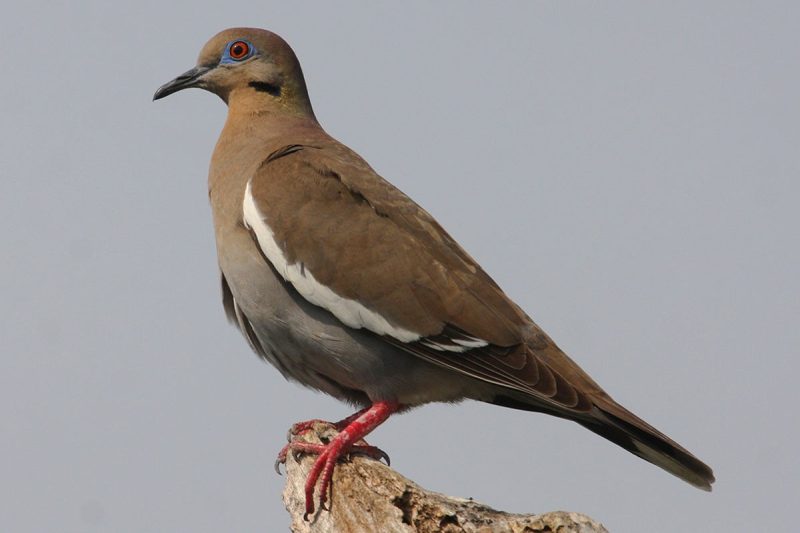
The White-winged Dove is larger than the Mourning Dove and is easily identified by the distinctive white stripe along the edge of its wings, visible during flight. Its overall plumage is a soft grayish-brown with a slightly lighter belly and a subtle blue ring around its red eyes. This species has a deep, rolling cooing call that echoes through suburban neighborhoods and gardens.
White-winged Doves measure about 11 to 13 inches in length with a wingspan of 18 to 22 inches. They are strong fliers and often seen flying swiftly between trees or perching quietly on power lines. Their behavior is calm and they frequently feed on seeds, grains, and small fruits both on the ground and from feeders.
In Louisiana, these doves are common in urban and suburban areas, especially gardens, parks, and residential yards. They prefer warm climates and tend to be more abundant in the southern parts of the state. Their adaptability to human environments has allowed them to thrive alongside people.
Chipping Sparrow (Spizella passerina)

The Chipping Sparrow is a small, slender songbird noted for its rusty cap, black eye line, and grayish body. Its clear, mechanical “chip” call gives this bird its name. These sparrows are lively and often found hopping on or near the ground as they forage for seeds and insects.
Chipping Sparrows are about 5 inches long with a wingspan of 7.5 to 9.5 inches. They frequently gather in small flocks during the winter months, moving between low bushes and grassy patches. Their quick movements and steady calls make them easy to spot in open habitats.
In Louisiana, Chipping Sparrows appear mostly during fall and winter, favoring open fields, lawns, and edges of woodlands. They feed on a diet of seeds and small insects. Their preference for grassy and shrubby habitats near the ground makes them common in suburban parks and open countryside during the colder months.
Eastern Phoebe (Sayornis phoebe)
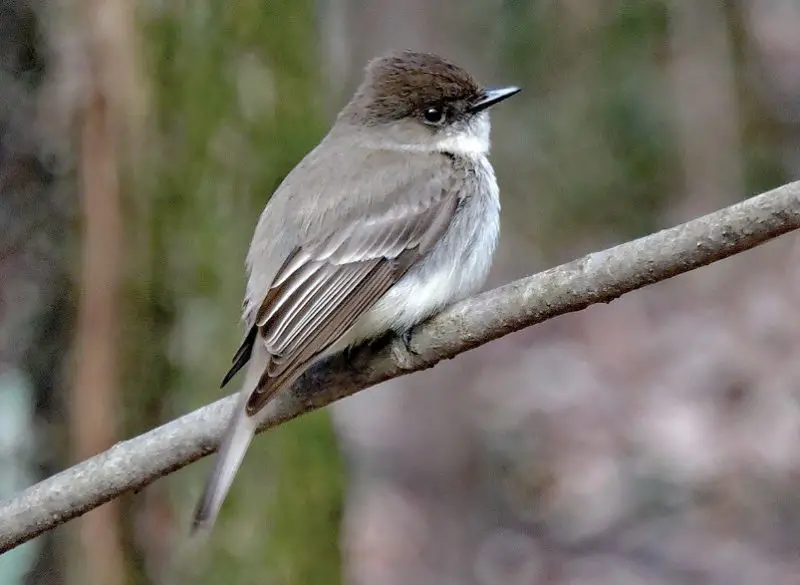
The Eastern Phoebe is a small, plain-looking flycatcher with a gray-brown back, lighter underparts, and a characteristic habit of wagging or “pumping” its tail downwards. Its soft “fee-bee” call is one of the first signs of spring in Louisiana. Phoebes are often seen near human structures, where they nest under bridges, porches, and barns.
Measuring about 6 to 7 inches long with a wingspan of 11 to 12 inches, Eastern Phoebes hunt insects by sallying out from perches to catch flying prey midair. They are often observed flicking their tails while perched and are known for their adaptability to nesting near people.
In Louisiana, Eastern Phoebes are common year-round residents, especially around towns, farms, and rural areas. Their nests are usually cup-shaped and built of mud and moss, often attached to ledges or eaves. Their insect-based diet helps control pests in suburban and agricultural environments.
House Finch (Haemorhous mexicanus)
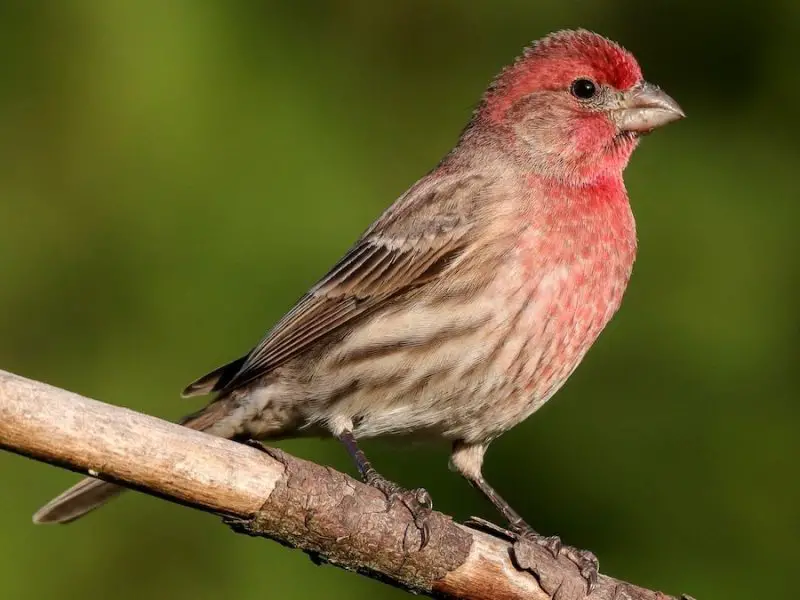
The House Finch is a small songbird well known for its vibrant red coloration on the head and chest of males, while females display streaked brown and beige plumage. These finches have a cheerful, warbling song and are frequently found at bird feeders or around human habitation.
House Finches are approximately 5 to 6 inches long with a wingspan of 8 to 10 inches. They are social birds, often gathering in flocks and moving actively through trees and shrubs. Their adaptability to various environments and abundant presence make them one of the most common backyard birds in Louisiana.
In the state, House Finches live year-round in urban and suburban areas, parks, and open woodlands. They feed on seeds, berries, and small fruits, and are attracted to feeders stocked with sunflower seeds and millet. Their friendly nature and bright colors make them favorites for many bird watchers.
Brown Thrasher (Toxostoma rufum)
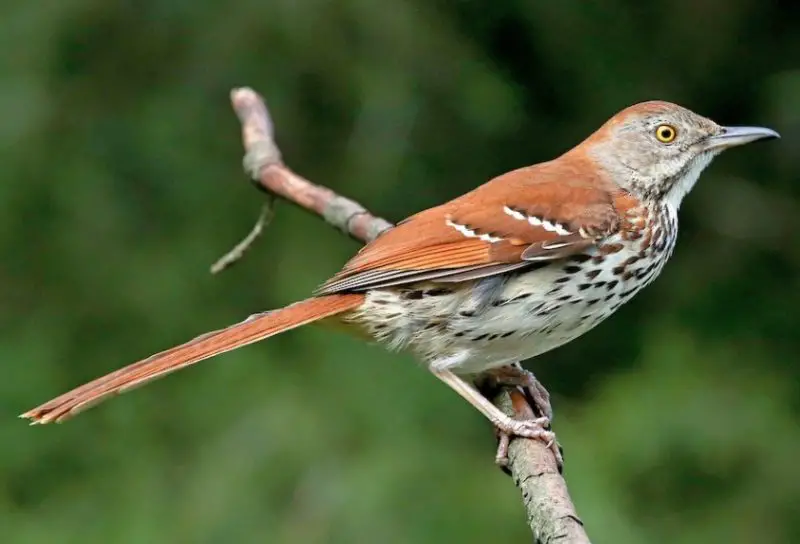
The Brown Thrasher is a medium-sized songbird with striking reddish-brown upperparts and heavily streaked underparts. It has a long tail and a curved bill, which it uses skillfully to dig through leaf litter in search of insects and other invertebrates. The bird’s rich, melodious song includes a wide variety of repeated phrases.
Measuring about 10 to 12 inches long with a wingspan of 12 to 15 inches, Brown Thrashers are ground foragers often seen hopping or scratching under dense shrubs and thickets. Their sharp eyes and quick movements make them expert hunters of hidden prey.
In Louisiana, Brown Thrashers are common in brushy areas, woodland edges, gardens, and overgrown fields. They feed primarily on insects, earthworms, and berries. Their shy but vocal nature, combined with their beautiful songs, makes them a distinctive presence in the southern landscape.
Best Time and Places to See Birds in Louisiana
Louisiana’s diverse habitats—from coastal marshes and swamps to forests and urban parks—make it a fantastic destination for birdwatching year-round. However, certain seasons and locations offer better opportunities to observe specific species and larger concentrations of birds.
The best time to see many migratory birds is during spring (March to May) and fall (September to November) migration periods. During these times, Louisiana serves as a crucial stopover for hundreds of bird species traveling between breeding grounds in the north and wintering areas in the south. Coastal areas like the Mississippi River Delta, Barataria Bay, and the Chenier Plain are especially popular for witnessing impressive flocks of waterfowl, shorebirds, and wading birds.
Winter (December to February) brings large numbers of waterfowl such as Canada Geese, Mallards, and various species of ducks to the state’s lakes and wetlands. Places like Caddo Lake, Lake Martin, and the Atchafalaya Basin provide excellent birdwatching during colder months, attracting species like Bald Eagles and Snowy Egrets as well.
For year-round birdwatching, national and state parks such as Fontainebleau State Park, Bayou Sauvage National Wildlife Refuge, and the Kisatchie National Forest offer habitats rich in resident birds like the Northern Cardinal, Red-bellied Woodpecker, and Carolina Wren. Urban green spaces and backyard feeders, especially in cities like New Orleans and Baton Rouge, are also great spots for observing common species such as House Sparrows, Mourning Doves, and American Goldfinches.
Morning hours, shortly after sunrise, are typically the most productive for birdwatching, as many birds are active and singing to defend territory or attract mates. Visiting during mild weather and after rainfall can also improve chances of spotting a variety of species. Whether you are a casual observer or an avid birder, Louisiana’s rich birdlife and varied ecosystems provide countless rewarding experiences throughout the year.


